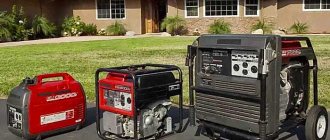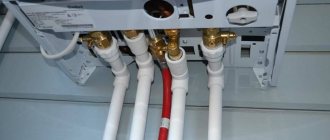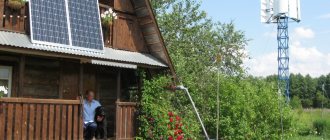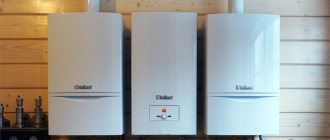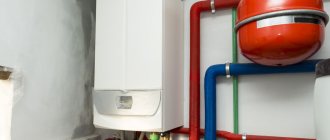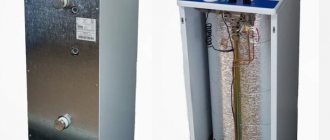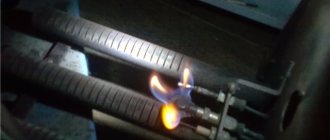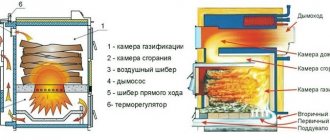Heating schemes with natural circulation are being systematically replaced by the use of forced circulation, where there is no need to wait a long time for the entire circuit to warm up and spoil your interior with vertical pipe risers. Modern boilers operating on gas or solid fuel are increasingly being controlled by electronic controllers that can optimize their operation. However, all these innovations depend on electricity; if it is not there, then there will be no heating in the house. There is no need to put up with this, there is a solution - uninterruptible power supplies for the heating boiler, with the help of which you can survive even daily power outages and heat the house as it should be.
Uninterruptible power supply for the boiler depending on the situation
So, let's begin to understand each situation described above separately.
When the networks are worn out and short-term surges in consumption (a powerful welding machine, connecting a powerful heating device) can leave a block or village without electricity for a short period of time, it is worth thinking about backing up the boiler power using an uninterruptible power supply (UPS) with a rechargeable battery (AB).
The most ordinary computer UPS, unfortunately, cannot help in this situation. Its battery is enough to power the boiler for 3-5 minutes. In addition, at the output it does not produce a pure sine wave, which is necessary to power boiler equipment and a circulation pump, but an approximation of a sinusoid or meander. This is a form of output voltage that can cause damage to your boiler equipment.
Therefore, you will need a UPS that has a pure sine wave output and is capable of working with connected batteries.
If the emergency power outage period increases to 6 hours, you should consider using a 100 A*h battery as a power source for the boiler and circulation pump. This capacity will allow the boiler burner and boiler automation to operate for up to 8 hours without recharging the battery.
Even a day, that is, 24 hours, will not be an obstacle to powering the boiler from the battery, you just need to calculate the battery capacity for this period. A battery with a capacity of up to 200 Ah is suitable.
But a power outage for more than a day should make you think about purchasing a gasoline generator in addition to the UPS and capacious batteries.
It is best to buy an inverter generator, because only an inverter generator has a pure sine wave output, which is so necessary for modern boiler equipment.
Accidents lasting more than 3 days leave you no choice - only a generator. No UPS power system with a reasonable number of batteries will withstand such a period and will not be able to provide autonomous power to the boiler. Unless you are ready to install 5 batteries with a capacity of 100 Ah in your boiler room. And then, they will have to be charged with the same generator, since the total capacity of 500 Ah is not enough to power the boiler equipment for 72 hours.
The power source for the boiler thus appears as follows:
- For short-term outages up to 24 hours - a UPS with a battery.
- For outages from 1 to 3 days - a UPS with a battery and recharging from a gasoline generator.
- For outages of more than 3 days - only a gasoline inverter generator or a generator with a separate inverter.
The criteria by which you should choose a power source for a heating boiler are very simple:
- Pure sine output.
- Possibility of connecting external batteries.
- Possibility of connecting a large capacity battery (ideally up to 600 A*h in total).
- Reliability and ease of execution.
- Developed service support in your locality.
The last point is important, because in the event of an accident, a faulty UPS is actually a “dead” boiler, and, as a result, the heating system of your home freezes.
All of the above criteria are applicable to all modern heating boilers - gas, diesel, solid fuel, pellet. You can back up an electric boiler in case of an emergency either with a boiler using a different type of fuel, or with a generator if the boiler power does not exceed 5-8 kilowatts. Otherwise, you will have to buy a gasoline generator that is too powerful.
Are power outages dangerous?
Sellers of non-volatile appliances and uninterruptible power supplies tell customers chilling stories that look quite plausible. A person who does not understand anything at all about the design of a boiler will believe that if the current is lost, the gas supply to the burner continues.
What's really going on? When the temperature sensors, electronic control unit and pump are turned off, uncontrolled combustion of fuel occurs in the combustion chamber, which means overheating of the liquid in the heat exchanger.
Accordingly, the tubes cannot withstand, they become deformed, burst, and the water from them extinguishes the burner of the atmospheric gas boiler. Gas enters the room and creates an explosive situation or simply poisons people and animals. And if a forced-air ventilation system is installed in the boiler, go outside. This is also unsafe and not environmentally friendly.
Do you agree that it sounds plausible and scary? Have you already decided to run for a non-volatile boiler? But in vain!
Do not avoid performing maintenance on gas appliances and their components. Checking will show their performance, especially after power outages
In fact, electrically dependent boilers occupy a leading position in the sales market. They are installed in holiday villages, private houses, with owners spending half a day at work, and in non-residential premises where long-term repairs are being carried out.
Power outages, as mentioned earlier, are quite common. And for some reason there is no data on hourly large-scale tragedies of carbon monoxide poisoning or explosions.
Moreover, such a dangerous device would not be certified and could not in any way comply with GOST, which means that gas workers would not allow it to be used.
And now the technical details. In fact, the devices have a reliable system that ensures that the boiler is turned off in the event of force majeure, including a power outage.
Power backup time
Perhaps the priority factor that determines the choice. UPSs for computers are capable of providing power for a very short period of time - no longer than 10 minutes. This is explained by the use of a small number of batteries, placed either in the equipment housing or separately.
Specialized ready-made solutions for boilers take into account the requirements for battery life, which ranges from 8-12 hours to a day or more. At the same time, other parameters are provided that guarantee the operation of the equipment of the autonomous heating and hot water supply system of a private house, cottage, or even apartment:
- “Pure sine” at the output - the absence of “modified” pulse voltages that are unacceptable for sensitive automation and pumping equipment.
- Long backup time for uninterrupted operation of boiler equipment is at least 6-8 hours (depending on the equipment and the volume of batteries of the inverter system - over 12 hours). It is possible to install the battery for a reserve of 2-3 hours, if necessary.
- Preservation of operability under repeated overloads. Computer UPSs are able to withstand such tests, but the life of their batteries in this case is significantly reduced.
Long-term reserve is perhaps an equally important parameter. With frequent and relatively long-term discharging and charging, the batteries of computer power supplies quickly fail. As a result, their reservation time is significantly reduced. As for special UPSs for the home and boiler, a block of AGM batteries is installed separately in them. There are no difficulties with how to connect additional batteries if the current total capacity of the batteries is not enough to meet the needs of the gas boiler.
Recommendations for use
- If the gas valve malfunctions, it is necessary to check it and adjust the settings. If the heat exchanger is covered with a large layer of scale, this greatly reduces heat transfer and significantly increases fuel consumption. In such a situation, the boiler makes a cracking or noise. This occurs due to the accumulation of salts, which slowly fall off the surface over time, which is why the noise is heard. They can be removed using special reagents.
- Often you have to deal with components wearing out too quickly. The main reason for this is timing. In this case, the gas boiler can automatically turn on and off. When the water in the circuit cools down, a signal is received from the thermostat that the water has cooled, in which case the boiler turns on.
To learn how to choose a gas boiler, see the following video.
Criteria for choosing a UPS for a gas boiler
From all that has been said, we can deduce the following requirements for an uninterruptible power supply for a gas-fired boiler:
- Special UPSs with an output voltage in the form of a sine wave are required. Uninterruptible power supplies are not suitable for computers. At the output they produce not a sinusoid, but a meander - the voltage is also alternating, but not round, like a sinusoid, but with a cut off top. For computers, such voltage is not a hindrance, but for a heating system it’s even worse. Such voltage has a bad effect on circulation pumps - they hum and operate jerkily. As a result, the impeller quickly wears out and the pump has to be replaced.
- The power of the UPS is selected with a reserve. If possible, double the power consumption.
- It is advisable to choose the online type; a good option is the interactive type.
- The capacity of the batteries must be selected so that if the power supply is turned off, the heating can operate for several hours (at least). This requirement is not critical if there is a generator. In this case, the battery should last long enough for it to start. By the way, this is another reason why you should not install computer uninterruptible power supplies for the boiler - they are designed to operate the equipment for 10-15 minutes. During this time, you can correctly shut down all programs and turn off the equipment. For the boiler, these minutes are too short a time.
- It is desirable that it be possible to connect additional external batteries (there must be connectors). This will be useful if you decide to increase the operating time of the heating from a backup power source or when connecting other equipment. Connection diagram of a gas boiler to an uninterruptible power supply (UPS)
The requirements are not the most stringent, but it is advisable to adhere to them. When connecting an uninterruptible power supply, observe the phasing (the UPS phase must be connected to the boiler phase, zero and minus to the corresponding conductors). Otherwise the boiler will not work. Checking the correct phasing is simple: unplug the boiler from the network. The boiler must continue to operate. If the flame goes out, check the correct connection and proper grounding. If everything is normal, but the boiler still does not work, then your UPS is built without a “through zero”. To start the boiler, you need to connect the neutral N (zero) terminals at the input and output to the uninterruptible power supply. For most boilers, such a modification solves the problem. But there are some brands of boilers, for example, Buderus, which need to install a resistance of 1 to 10 MOhm between the PE and N inputs (ground and zero) (Buderus even offers to buy their branded resistor).
Actually, this is all about choosing and even connecting an uninterruptible power supply for a gas boiler.
Can electricity be cut off in winter due to accumulated debt?
In this case, the consumer must be notified in writing at least 10 days before the expected date of introduction of the restriction (power outage).
All the reasons why the supply of electricity is interrupted, not counting the termination of the contract between the supplier and the consumer, can be divided into two groups: technical and economic.
I live in Crimea, in Feodosia. When dialing a number, the phone immediately turns off. And the question: A transit riser (MCD) passes through the apartment. The apartments have individual heating. The first floor is a branch of the State Treasury, which, in the process of an uncoordinated renovation, flooded us on the 3rd and 2nd floors with twice-cold water and after 4 four days with hot water. The downstairs neighbor was persuaded to make me the defendant. Who is the owner of the transit pipe?
Types of stabilizing devices
If home owners are planning to connect a gas boiler through a stabilizer, then the first thing they need to consider is the range of such devices. After becoming familiar with the types of devices, it is easier to choose the one that will be optimal in specific conditions. When choosing the ideal option, consider:
- price of the device;
- its service life;
- operating principle of the device;
- performance of the stabilizer;
- voltage range: input and output.
Another characteristic is quiet operation, but it is not as important as the main ones. The operating temperature range for stabilizing equipment is from +5° to +40°. The last criterion is the placement method. Wall-mounted models are lightweight, compact, and therefore convenient. Floor-standing (desktop) devices are required for high-power equipment.
Triac (thyristor)
These stabilizer models are now considered the best. They have a long service life and are absolutely silent. Other advantages:
- performance - maximum 10-20 ms;
- input voltage range - 120-280 V;
- output voltage accuracy - 1-2.5%;
- The maximum control accuracy error is 0.5%.
The operating principle of the device is the use of electronic keys to switch the transformer. Thanks to this solution, the response speed of the devices is guaranteed. If one of the triacs fails, the stabilizer remains in working condition, so it is suitable for those networks in which voltage drops and surges are considered the norm. The disadvantage of the models is the relatively high price. However, it is possible to find a device with an ideal cost-quality ratio.
Inverter
These newest models have virtually no weak points. Apart from the high cost. Double conversion stabilizers have the following characteristics:
- performance is maximum, since there are no delays;
- input voltage range - 120-300 V;
- long service life;
- no interference.
The principle of their operation is double conversion. First, alternating current is transformed into direct current, then it is converted again, but into alternating current with a constant frequency. The result is a stable sine wave. The disadvantage of inverter stabilizers is their low efficiency when compared with other types of devices. The high price is the reason why many owners of gas boilers decide to buy not a stabilizer, but a UPS.
Electronic (relay)
These devices will prove useful where variations are minor and relatively rare. Their characteristics:
- performance - 100 ms;
- voltage range - 135-315 V;
- output accuracy is 7.5%.
The advantages of the devices include the absence of distortion of the network sinusoid, insignificant noise, since a microprocessor is used for control. Its disadvantages: not very high quality, short service life. Hybrid models protected by resistors do not have the last disadvantage.
Electromechanical (servo-drive)
These devices use a slider that moves the brushes using an electric motor. In this way, the turns of the secondary winding are switched. Advantages of the devices:
- smooth adjustment, precision operation;
- stability, ability to withstand extreme loads;
- low price of servo stabilizer.
Due to heating, it is unsafe, as it can easily cause a fire. For this reason, it is better to exclude servo-drive models from the list of candidates for gas equipment. Alternatively, they can be considered for installation in another room.
Stabilizers with PWM
Pulse width modulation devices use a special pulse generator. Depending on the difference between the input and output voltages, the parameters of the generated waves change. The result is a stable output frequency. The advantage of pulse stabilizers is complete protection and guarantee of maximum equipment performance and the performance of its processor. Such models are chosen for networks characterized by constant low voltage.
Fed
Ferroresonant stabilizers are another type, but they are practically not used in everyday life. These stations are installed in high-power boiler houses. The reason is the high price, which is comparable to the cost of a UPS. In this case, connecting a gas boiler through a stabilizer in a private house is completely unjustified.
Algorithm for selecting an emergency power source for a pump
- According to the documentation for the pump, we look at its maximum consumption mode. Even if it is not set at the highest level now, it is not at all certain that it will not have to be set to the maximum in the future. For example, Grundfos UPS 25-40 180 can be used in 3 modes: 25, 35 and 45 W. To determine the required UPS power, we use 45 W.
- We take into account the starting currents of the pump, i.e. increase in power at the moment of switching on. Provided that more than one pump is used in the system, the maximum power of the system should be calculated as the sum of the starting powers of all pumps used. For example, about the already mentioned circulation pump Grundfos UPS 25-40 180 it is known that it belongs to energy efficiency class B. Accordingly, at the moment of switching on, it will require 45 W * 5 = 225 W.
- We take into account a power reserve of 15-20%. Those. the required preliminary figure: 225 W * 1.2 = 270 W.
- From the available range of suitable UPSs, we select the one whose power is as close as possible to the obtained figure, but not less than it. In our case, an uninterruptible power supply with a power of 300 W is suitable. We understand that it will no longer be possible to “hang” anything else from electrical appliances on it.
- Next, you need to select external batteries based on the rated power of the pump and the required autonomy time (due to the short start-up modes, their power is not taken into account). If the frequency of operation of the pump is known, for example, it runs 40 minutes per hour and this is enough to maintain comfortable heat in the house, we can take this circumstance into account. Just remember that such accounting is possible for the lowest possible temperature in your area. We can take this factor into account by recalculating the time of autonomous rated power with a factor of 2/3 (40/60 minutes).
Different UPS models of the same power each have their own number of batteries in the battery set, so if there are several options, you have to calculate each of them separately. The easiest way to select a battery kit is to do it with the help of a consultant, but you can roughly navigate yourself using the autonomy tables given in the description of each UPS on our website.
How to connect a gas boiler in a private house in order?
It is possible to install and connect the device correctly on your own, but this requires approval from gas services. In the course of the work, thoughtful activity and the need for paperwork will be required: agreeing on a number of issues and obtaining documents.
First, an agreement is drawn up with a natural gas supplier for its supply to private households. They are also involved in the project of gasification of the building and installation of the necessary equipment.
Before installation, all papers (certificate, product serial number) are verified. If everything is in order, proceed to installation.
The installation location is selected depending on the type of device.
The floor-standing gas boiler is installed on a flat surface made of non-combustible materials. For example, tiles or concrete screed are used. And sometimes they put a sheet of galvanized steel with a protrusion on the front side of up to 30 cm. Access to the structure should be unlimited from either side.
Important! It is necessary that the boiler is located away from electrical appliances and fire sources, and not close to the wall. The structure must have a uniform load on all supports
The structure must have a uniform load on all supports.
The wall-mounted gas boiler is secured using brackets (included in the kit). Installation height is about 1 meter above the floor. First, the planks are fastened, then the unit is mounted on them.
Then the connection to the chimney occurs. Before this, the presence of traction is checked. To prevent the leakage of toxic gases, the connections are carefully sealed.
Photo 3. Wall-mounted gas boiler, installed more than a meter higher from the floor, connected to the chimney.
25 cm is the maximum length of the pipe section that connects the boiler to the chimney.
The next step is connecting to the water supply. The first step is to install a filter for hard water purification, which prevents the heat exchanger from clogging. Taps and/or valves are installed on both sides of it.
To ensure optimal pressure in the system, tapping into the water supply is carried out either to the point where the pipe branches, or as close as possible to its entrance to the building. Typically, the water supply pipe is connected to the top of the unit, and the return pipe is connected to the bottom.
All communications must be equipped with a locking mechanism to enable emergency shutdown of the gas supply in case of danger.
Materials and tools
- Adjustable wrenches and dowels;
- building level for choosing the location for attaching the brackets, its length should not be less than 1 meter;
- a hammer drill with a set of drills of different diameters for making holes in the wall intended for fastening them;
- brackets - included in the kit, but it is better to have some in reserve;
- scissors, so that when cutting pipes, they do not damage their protective layer, which is responsible for the tightness;
- calibrator for pipe flaring;
- valves, taps - for fastening locking mechanisms;
- galvanized steel sheets and tools for cutting them.
Step-by-step connection of the heating circuit
There are several ways to connect the circuit to the boiler, depending on the model and auxiliary equipment.
When connecting a single-circuit gas appliance to a heating system, the easiest way is to use shut-off valves and use them to connect the circuit directly to the boiler.
The coolant circulates in a natural mode, and a conventional expansion tank is installed in the system.
When connecting double-circuit devices, the work becomes more complicated, since a double set of pipes is supplied to the boiler. The coolant flows directly through one, and hot water circulates through the second. The connection is also established using shut-off valves.
If the system is closed, then additional devices must be installed: a circulation pump, a membrane expansion tank and a safety group.
Connection to the heating system
Location of connections to the heating system (from the front side):
- on the left - supply of hot coolant to the circuit;
- on the right is the return line.
When connecting the boiler, you should carefully check the sealing and tightening of the components, but you should not be too zealous because of the risk of damaging the threads and facing the problem of replacing all connecting elements.
It is also necessary to install a coarse filter on the return line, which will extend the life of the device by stopping solid particles.
How to make an uninterruptible power supply for a heating pump with your own hands
Many people who are inclined to save money are accustomed to doing everything themselves. This is commendable, as it indicates the presence of brains and direct hands. To make a UPS for a heating circulation pump with your own hands, you will need additional knowledge in the field of electrical engineering - you need to assemble a converter (also known as a charge controller). If you don’t have the appropriate knowledge, then it’s better not to take it on.
As an introductory example, we present a circuit diagram of an uninterruptible power supply for a heating pump using domestic radio components.
Stabilizer: to be or not to be?
Most Russian power grids are very far from ideal. Outdated equipment and frequent violations that occurred during installation are to blame for their low quality. As for voltage, it is often lower than standard indicators - 220 V - by 10-15%.
We need a defender: the pros
Power surges that occur due to the arrival of a thunderstorm front, hurricane winds, or the owners or neighbors turning on powerful equipment—a washing machine, a new “cool” refrigerator, a vacuum cleaner, tools, or electric heaters—are already considered a normal phenomenon.
A voltage stabilizer (electrical or electromechanical) maintains this value within a certain range. At 200 V, modern models can function, but when reduced to 180 V, the risk of malfunctions or complete shutdown of the equipment increases. A voltage surge up to 250 V leads to burnout of electrical circuits. Replacing them is expensive: for repairs you will need to pay 30-50% of the price of a gas boiler.
The risk of being left with non-working equipment is eliminated by connecting a gas boiler through a stabilizer. An unstable mains voltage is supplied to its input, and at the output it is converted into an ideal 220 V with a pure sine wave. The system will function without overload, which means that breakdowns due to voltage are excluded. If it is impossible to stabilize the parameters, the device simply breaks the circuit, protecting the unit from overload.
The device is not needed: arguments against
Some owners are skeptical about such protection. They claim that buying a stabilizer is a waste of money. A typical argument is the absence of serious network surges. However, no one can be immune from them. There are other arguments in favor.
- Any natural disaster, even strong winds, can negatively affect power lines.
- The human factor also plays a significant role. No one can be insured against the “visiting” of an unscrupulous electrician, or against accidental damage to electrical wiring.
Another potential threat is the ever-expanding range of household appliances. Its abundance leads to the “fouling” of houses with all sorts of powerful energy consumers, and this is an almost one hundred percent guarantee of a power surge.
When does a stabilizer not help?
Connecting a gas boiler through a stabilizer is necessary if power surges are short-term and power outages are rare. Most devices will not help in the following cases:
- when a power line is struck by lightning, a surge protector will save you from it;
- if there is a sudden and long-term power outage, a UPS is needed for such situations;
- when you need to correct the frequency of the input voltage: only inverter models can do this.
A possible alternative to an inverter stabilizer is an online UPS (double conversion technology).
Potential, cheaper replacement
Less expensive devices can handle the task assigned to the stabilizer:
- A regular surge protector can protect a gas boiler. Or the one that is included in the UPS, although it can no longer be called a cheap purchase.
- It is easy to prevent power failure due to high or low voltage using a power control relay.
The best option is an inexpensive UPS online. If you also add a surge protector and a voltage relay, then such comprehensive protection can already be called almost impenetrable. To be or not to be a separate device, everyone decides for himself. Connecting a gas boiler through a stabilizer is one of the options, but the owners of the equipment must choose the method of protection.
Operating principle
Regardless of the manufacturer, a modern device consists of the following components:
- Input filter. Smoothes out electrical circuit noise.
- Rectifier. Converts alternating current into direct current, stabilizing it. This charges the battery and keeps it ready for use.
- Inverter. Performs the opposite function - direct current turns into alternating current.
- Converter. Increases the voltage from the battery to the parameters that are necessary for the inverter to operate.
- Directly the battery. Modern models are equipped with a built-in battery, leaving the option of connecting external storage devices.
Based on the configuration, we can formulate the operating principle:
- External voltage is filtered, stabilized, and then supplied to the connected devices. At the same time, the battery is charged (or maintained charge);
- When there is a power outage, the direct current from the battery is converted into alternating current with ideal parameters. External devices are powered using the capacity of the storage device.
Correct installation of a wall-mounted gas boiler
The gas boiler of this modification has a self-diagnosis function. Baxi heating systems and their maintenance Although Baxi devices and systems are famous for their reliability and durability, trouble-free operation, gas boilers still require periodic maintenance and repair work. All of them are double-circuit due to the installed bithermic heat exchanger, and have electronic protection against scale. If you look closely at the diagram, you will see that the system includes both a radiator system and a heated floor system. Make electrical connections according to the electrical diagram given in the instructions.
Automatic bypass; Possibility of working on liquefied gas after reconfiguration.
Gas valve. At the same time, the maximum power consumption of the electrical network is 25.8 kW, and the largest heating area is square. Main 5 boilers are equipped with a bithermic heat exchanger, which simultaneously heats both running water and coolant. And so, having passed through all the radiators, the coolant finally enters the return pipeline.
In the photo you can see the location of the various parts under the cover. Heating circuit temperature sensor; Connecting the Emmeti Termec room thermostat to a baxi gas boiler
Advantages and disadvantages
The advantages of non-volatile boilers include:
- there is no dependence on the availability and quality of power supply;
- simplicity of design, absence of minor parts;
- guaranteed continuity of the home heating process;
- the cost of the boiler and repair work is significantly lower than that of energy-dependent models;
- You can do maintenance and cleaning yourself.
Disadvantages are considered to be:
- the protection system is limited to several sensors;
- there is no possibility of remote control;
- The operation of the boiler depends on external factors that cannot be adjusted.
IMPORTANT!
Despite some disadvantages, non-volatile boilers are a practical and reliable solution. In some settlements they have no competitors due to power outages.
Connecting a gas boiler through a stabilizer
- Like other electrical appliances, the stabilizer should be located in a dry room. High humidity is contraindicated for it.
- The housing must not be located near flammable or combustible substances.
- A constant flow of fresh air is a must.
The device is connected to the electrical network through a grounded socket. Wall-mounted models are mounted in close proximity to the gas boiler. The device is connected to it using a socket on the stabilizer body. The following diagram will help you understand the connection:
Connecting a gas boiler through a stabilizer is an operation that will protect expensive equipment from power surges, give it the ability to operate uninterruptedly, and help it last for many years without breakdowns. However, when choosing a model, all important parameters must be taken into account. Otherwise, you can buy an unsuitable or unreliable device that will not provide adequate protection to the system.
To complete the topic of stabilizers, you can watch a video dedicated to these devices:
Starting currents
The third important point is the starting currents or power that is required to start the equipment. To do this, it is necessary that one important rule be observed: the starting power must be several times higher than the rated power.
But even here it is very important that its value does not exceed the maximum permissible. Otherwise, all parts will wear out much faster, which will cause the UPS to fail ahead of schedule.
It is better to connect batteries in parallel than in series
There is an opinion that it is better to take a UPS with a 12V battery voltage and connect several batteries in parallel to increase the total capacity than to take a 24/48V UPS and connect the same batteries in series. As an argument, the need to balance batteries is usually given if they are connected in series, but what is overlooked is that each battery consists of 6 elements, balancing of which, in principle, is not provided for by the design of the battery, and yet it still works somehow. In my case, 4 12V batteries are connected to two UPSs; after two years of use, the difference in battery voltage was less than a tenth of a volt.
Structure of heating systems
Thin metal-plastic and metal pipes used in modern heating systems do not allow for natural coolant circulation. Also affected by the absence of slopes, the presence of a large number of connecting fittings, the minimum internal volume of radiators and many other factors. To ensure that the coolant can circulate freely through the pipes and deliver heat to all corners of the house, circulation pumps are installed in the heating circuits.
Pumps used in heating are built according to a “wet” rotor design. Thanks to this, they are compact and silent. The pump units are powered from a household single-phase network with a voltage of 220 Volts. Despite the fact that rolling power outages are no longer practiced, the stability of the supply of electricity to houses and apartments remains a sore domestic issue.
In the absence of an uninterruptible power supply, each power outage leads to difficult circulation or even its cessation. The house becomes cooler, and the heating boiler, diagnosing overheating of the boiler water, turns off. If the “lights” are turned off for several hours and there is no thermal insulation, soon the air temperature will begin to drop - the conditions for staying in the rooms will not be the most comfortable. There is only one conclusion - you need an uninterruptible power supply.
Review of popular models
| Model | Type | Power, W | Capacity, Ah | Input voltage range, V | Number of sockets for consumers | Interfaces for connecting to a PC | Cost, from (rub.) | Customer Reviews |
| BASTION TEPLOCOM-300 | Off-line | 270 | 26–65 (2 pcs., external) | 185–245 | 1 | No | 8600 | Advantages: 5-year warranty, compact size, suitable for phase-dependent boilers, quick switching to reserve. Disadvantages: lack of a voltmeter, universal but inconvenient mounting, no stabilization (when operating from the network). |
| BASTION TEPLOCOM-600 | Line-interactive | 450 | 40–120 (2 pcs., external) | 188–245 | 1 | No | 11500 | Advantages: 5-year warranty, good battery life, suitable for phase-dependent boilers, good voltage stabilization, support for working with a generator. Disadvantages: lack of voltage and operating time indication, not the fastest transition between modes. |
| INELT Monolith K1000LT | On-line | 700 | 45–150 (3 pcs., external) | 120–295 | 2 | RS-232 | 18000 | Advantages: long battery life, instant switching to reserve, precise stabilization, detailed indication on the LCD display. Disadvantages: not suitable for phase-dependent boilers, noisy, rather large. |
| RUSELT Istok IDP-1-1/1-1-220-A | On-line | 800 | 18 (2 pcs., 12 V 9 A*h, built-in) | 120–300 | 3 | USB, RS-232, SNMP (board sold separately). | 20000 | Advantages: power, precise stabilization, instant switching, comes complete with built-in batteries. Disadvantages: short battery life. |
| Helior Sigma 2 KSL | On-line | 1600 | 42–200 (6 pcs., external) | 138–300 | 3 | RS-232, USB | 33000 | Advantages: very powerful at an affordable price, generator support, high battery charging current, good stabilization. Disadvantages: noisy, some users had problems with reliability. |
| Stark Country 3000 online | On-line | 2400 | 65–230 (6 pcs., external) | 110-300 | 4 | RS-232, USB, SNMP | 28500 | Advantages: high power, works with phase-dependent boilers and generators, long battery life, high-quality circuit design and assembly. Disadvantages: noise during operation, short warranty period. |
SVEN RT-500
Which UPS should I choose for my home without spending too much? The Russian brand “Sven”, which belongs to budget models, will save you here. Small, small and powerful (300 watts). It operates from a standard single-phase network, so there are no problems with connection.
Like all equipment from this manufacturer, it is very easy to operate. You don't need any special knowledge to set it up and put it into operation. All values are displayed on a liquid crystal display and controlled by only 2 buttons.
The stability of the output signal is also high. Disadvantage: high noise level. It reaches 56 decibels, so can sometimes cause serious interference, especially during sleep. On the other hand, the question “which is the best wall-mounted power supply for a small apartment” is answered by this model.
Continuous
Uninterruptible power supplies of continuous type (on-line) provide stable output voltage and current readings, regardless of the quality of incoming electricity. Operation of the equipment when using continuous UPS is always provided by the battery.
It's all about the special operating principle of such devices:
- The voltage entering the UPS decreases, the alternating current is rectified, as a result of which the device’s battery is charged;
- Further supply of electricity occurs according to the reverse principle - the current is again converted into alternating voltage, the voltage increases and leaves the uninterruptible power supply.
Thanks to this operating principle, it is possible to achieve stable operation of heating equipment. Any voltage changes when using continuous UPS will not affect the operation of the boiler in any way. In addition, the presence of an uninterruptible power supply provides reliable protection of the boiler itself from damage.
The advantages of a continuous type UPS are obvious:
- Equipment connected to the device continues to operate normally even when the power is turned off;
- The characteristics of the electricity entering the device are stabilized, and the boiler does not feel changes in frequency and voltage at all;
- Heating equipment is reliably protected from damage caused by a sudden increase in voltage;
- The output voltage characteristics can be adjusted;
- If necessary, a continuous UPS can be connected to a generator to restore energy to the batteries.
Among the disadvantages, one can note only a decrease in efficiency, the presence of noise and heat emissions due to a working fan, as well as high cost.
